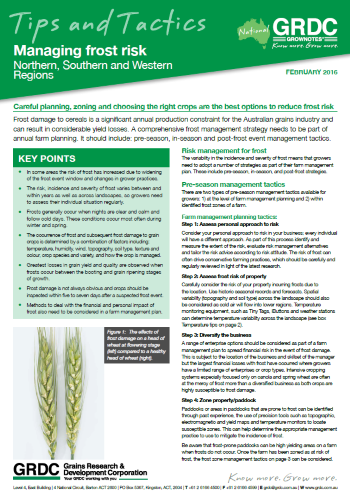Managing frost risk - Northern Southern and Western Regions
Managing frost risk - Northern Southern and Western Regions
Published: 9 Feb 2016
Careful planning, zoning and choosing the right crops are the best options to reduce frost risk
Frost damage to cereals is a significant annual production constraint for the Australian grains industry and can result in considerable yield losses. A comprehensive frost management strategy needs to be part of annual farm planning. It should include: pre-season, in-season and post-frost event management tactics.
Key Points
In some areas the risk of frost has increased due to widening of the frost event window and changes in grower practices.
The risk, incidence and severity of frost varies between and within years as well as across landscapes, so growers need to assess their individual situation regularly.
Frosts generally occur when nights are clear and calm and follow cold days. These conditions occur most often during winter and spring.
The occurrence of frost and subsequent frost damage to grain crops is determined by a combination of factors including: temperature, humidity, wind, topography, soil type, texture and colour, crop species and variety, and how the crop is managed.
Greatest losses in grain yield and quality are observed when frosts occur between the booting and grain ripening stages of growth.
Frost damage is not always obvious and crops should be inspected within five to seven days after a suspected frost event.
Methods to deal with the financial and personal impact of frost also need to be considered in a farm management plan.
Risk management for frost
The variability in the incidence and severity of frost means that growers need to adopt a number of strategies as part of their farm management plan. These include pre-season, in-season, and post-frost strategies.
Pre-season management tactics
There are two types of pre-season management tactics available for growers: 1) at the level of farm management planning and 2) within identified frost zones of a farm.
Want to link to this publication?
Use www.grdc.com.au/ManagingFrostRisk to ensure your link remains current and up-to-date!
Region North, South, West
Download PDF
Region: National

